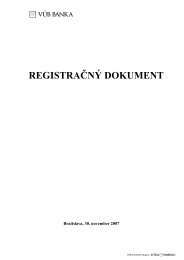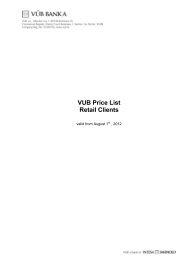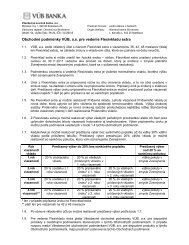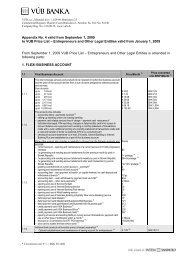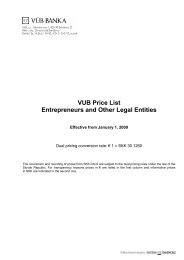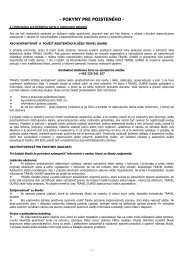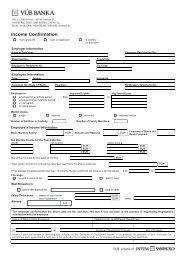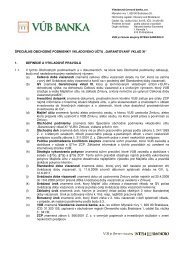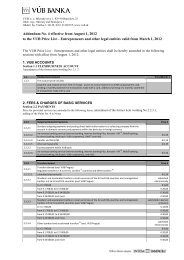Annual Report - VÃB banka
Annual Report - VÃB banka
Annual Report - VÃB banka
You also want an ePaper? Increase the reach of your titles
YUMPU automatically turns print PDFs into web optimized ePapers that Google loves.
2.28 Significant accounting judgements and estimates<br />
Judgements<br />
In the process of applying the Bank’s accounting<br />
policies, management has made judgements, apart<br />
from those involving estimations, that signifi cantly<br />
affect the amounts recognized in the fi nancial statements.<br />
The most signifi cant judgements relate to the classifi<br />
cation of fi nancial instruments.<br />
Held-to-maturity investments<br />
The Bank follows the guidance of IAS 39 on classifying<br />
non-derivative fi nancial assets with fi xed<br />
or determinable payments and fi xed maturity as<br />
held-to-maturity. This classifi cation requires signifi<br />
cant judgement. In making this judgement, the<br />
Bank evaluates its intention and ability to hold such<br />
investments to maturity. If the Bank fails to keep<br />
these investments to maturity other than for the<br />
specifi c circumstance, for example selling a higher<br />
than insignifi cant amount close to maturity, it will<br />
be required to reclassify the entire class as available<br />
for sale. The investments would therefore be<br />
measured at fair value and not at amortized cost.<br />
Fair value of fi nancial instruments<br />
Where the fair values of fi nancial assets and fi nancial<br />
liabilities recorded on the balance sheet cannot<br />
be derived from active markets, they are determined<br />
using a variety of valuation techniques that include<br />
the use of mathematical models. The input<br />
to these models is taken from observable markets<br />
where possible, but where this is not feasible, a<br />
degree of judgement is required in establishing fair<br />
values. The judgements include considerations of<br />
liquidity and model inputs such as correlation and<br />
volatility for longer dated derivatives.<br />
Impairment losses on loans and advances<br />
The Bank reviews its loans and advances at each<br />
reporting date to assess whether an allowance for<br />
impairment should be recorded in the income statement.<br />
In particular, judgement by management is<br />
required in the estimation of the amount and timing<br />
of future cash fl ows when determining the level of<br />
allowance required. Such estimates are based on<br />
assumptions about a number of factors and actual<br />
results may differ, resulting in future changes to the<br />
specifi c allowance.<br />
81<br />
Financial assets held for trading<br />
The Bank classifi es a fi nancial asset as held for trading<br />
if it is acquired principally for the purpose of<br />
selling it in the near term, or if it is part of a portfolio<br />
of identifi ed fi nancial instruments that are managed<br />
together and for which there is evidence of recent<br />
actual pattern of short-term profi t taking, or if it is<br />
a derivative.<br />
Estimates<br />
The preparation of the financial statements required<br />
management to make certain estimates and assumptions,<br />
which impact the carrying values of the Bank’s<br />
assets and liabilities and the disclosure of contingent<br />
items at the balance sheet date and reported revenues<br />
and expenses for the period then ended.<br />
Estimates are used for, but not limited to: fair values<br />
of fi nancial instruments, impairment losses on<br />
loans and advances to customers, provisions for<br />
off-balance sheet risks, depreciable lives and residual<br />
values of tangible and intangible assets, impairment<br />
losses on tangible and intangible assets,<br />
provisions for employee benefi ts and legal claims.<br />
In addition to specifi c allowances against individually<br />
signifi cant loans and advances, the Bank also<br />
makes a collective impairment allowance against<br />
exposures which, although not specifi cally identifi<br />
ed as requiring a specifi c allowance, have a greater<br />
risk of default than when originally granted. This<br />
take into consideration factors such as any deterioration<br />
in country risk, industry and technological<br />
obsolescence, as well as identifi ed structural weaknesses<br />
or deterioration in cash fl ows.<br />
Future events and their effects cannot be perceived<br />
with certainty. Accordingly, the accounting estimates<br />
made require the exercise of judgement and<br />
those used in the preparation of the fi nancial statements<br />
will change as new events occur, as more<br />
experience is acquired, as additional information is<br />
obtained and as the Bank’s operating environment<br />
changes. Actual results may differ from those estimates.<br />
VUB, a bank of Intesa Sanpaolo group



